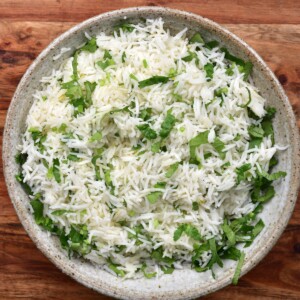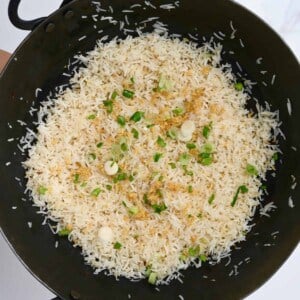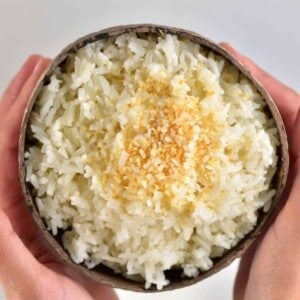This post may contain affiliate links. Please read our disclosure policy.
Learn how to cook jasmine rice on the stovetop perfectly every time. Use only 1 1/4 cups of water per 1 cup of rice to get fluffy and light jasmine rice time and time again.

For me, perfectly cooked rice maintains the individual grains and is slightly chewy, ever so slightly sticky, and, of course, fluffy and soft. However, following the package instructions doesn’t always lead to successful results. So, after some experimentation and lots of rice cooking, I have developed a foolproof method for perfectly cooked jasmine rice. For this recipe, you don’t even need a rice cooker or instant pot (though I do have an instant-pot jasmine rice version, too).
As with all rice, cooking jasmine rice on the stovetop comes down to a perfect rice-to-water ratio and using the steaming method. It’s important to know that jasmine rice is softer and needs less water—thus, the ratio of 1 cup of jasmine rice to 1 1/4 cup water is the one to remember.
Once ready, this rice is the perfect base for all your favorite stir fries (like this shrimp stir fry or this pepper steak stir fry) and stews (like this beef rendang recipe).

Want to save this recipe?
Watch the video tutorial
Ingredients

- Jasmine rice: It’s a long-grain variety originally from Thailand. It has a fragrant aroma, soft texture, and slightly sweet flavor.
- Water: You can use cold tap water. Remember, use only 1 1/4 cups of water to 1 cup of rice.
- Oil: The oil not only adds flavor to the rice but can also prevent it from sticking to the bottom of the pan if you let the heat get a little high. I love using coconut oil for more Thai-inspired flavors, but you can also use olive or another neutral oil.
- Salt.
See the recipe card for full information on ingredients and quantities.
How to cook jasmine rice on the stovetop
Rinse the rice: Either rinse the rice in a colander under running water or fill a bowl with water and add the rice. Then swish it with your hand, drain the water, and repeat 3-4 times until the water is mostly clear. Make sure to drain the rice well to remove any excess water.

Why rinse rice? Rice contains arsenic and heavy metals, though Thai jasmine rice, in particular, has lower amounts. Rinsing the rice reduces their amounts and removes excess surface starch from the grain, making the cooked rice fluffy.
Cook the rice: Next, add the water, salt, and oil to a medium saucepan and bring to a boil over high heat. Once boiling, reduce the heat to a gentle simmer and add the rice. Cover the pot with a tight-fitting lid (ideally, use a see-through lid).
Simmer for 12 minutes over low heat, then remove from the heat, keeping it covered, and allow it to steam for 10 minutes. If you find a little excess water in the pan at the end, quickly replace the lid and allow it to steam for a couple of extra minutes. Optionally, you can place a kitchen towel between the lid and pot to soak up the steam and stop it from condensing and falling back onto the rice.

Finally, fluff up with a fork, silicone spatula, or rice paddle and serve. Fluffy jasmine rice is a great addition to Southeast Asian dishes. Try it with Thai Red Curry recipe or Thai Green Curry recipe, other Thai food, stir-fries, and more. It can also be used as a substitute for basmati rice in Persian, Lebanese, Indian, and even British cuisine.
Simple tips for flavorful rice
While sometimes plain rice is what a meal needs, it’s nice to have some quick and simple methods for adding flavor when needed.
- Saute in oil: Saute the jasmine rice in olive or coconut oil for a few minutes before adding it to the water. This deepens the flavor and can add extra flavor without much effort.
- Add garlic: Saute some fresh garlic in the pot before adding the rice and liquid
- Add more salt: Be liberal when salting the water while cooking the rice.
- Use bouillon cubes: Add a stock cube to the water when cooking the rice, or use homemade vegetable stock instead of water.
- Add butter: Add a knob of butter to the rice after cooking for creamy, buttery results.

Make ahead
To store: Any leftover rice can be stored in an airtight container in the fridge for up to 5 days. Alternatively, it can be frozen for up to 6 months. I like to portion it into smaller freezer-safe containers and then freeze them.
To reheat: If the rice is frozen, there’s no need to thaw it before reheating. Reheat in a saucepan, adding about 1 Tbsp of water per cup of rice, and gently heat over low-medium until heated through. Alternatively, microwave it for 1-2 minutes, adding about 1 Tbsp of water per cup of rice and lightly covering the container to allow it to steam.

More simple rice recipes
If you try this jasmine rice recipe, let me know how it goes in the comments below. I’d appreciate a recipe card rating and would love to see your recipe recreations – tag me on Instagram @Alphafoodie!

Perfect Stovetop Jasmine Rice
Ingredients
- 1 cup Jasmine rice
- 1¼ cup water
- 1 tsp coconut oil or olive oil
- ½ tsp salt
Instructions
- Rinse the rice. Do so either in a colander under running water or fill a bowl with water and add the rice. Swish it with your hand, drain the water, and repeat 3-4 times until the water is mostly clear. Drain the rice well to remove any excess water.
- In a regular pot, add the water, oil, and salt and bring to a boil over high heat.
- Once boiling, reduce the heat to a gentle simmer and add the rice. Cover the pot with a tight-fitting lid.
- Simmer for 12 minutes over low heat.
- Remove from the heat, keep it covered, and allow it to steam for 10 minutes.If you find excess water in the pan at the end, quickly replace the lid and allow it to steam for a couple of extra minutes. You can optionally place a kitchen towel between the pot and the lid to help absorb the steam.
- Fluff the jasmine rice with a fork, silicone spatula, or rice paddle. Serve and enjoy!
Video
Notes
Nutrition
Nutrition information is automatically calculated, so should only be used as an approximation.













Perfect!! I love to use jasmine rice when cook stir fry, but I have trouble with it coming out too sticky. Finding this recipe was so great. The rice was fluffy, soft and not too sticky and tasty!
Thank you so much for your comment, Cleo. Glad you enjoyed the recipe!
This is definitely perfect Jasmine rice! I will never use the instant pot for rice again!
Hey Kristine! That’s amazing to hear! I’m so glad you loved the stovetop method—there’s just something about perfectly fluffy jasmine rice, right? Thanks for your kind words!
It worked! As if someone placed a curse on me, I am COMPLETELY unable to make rice correctly. It’s like I’m allergic to making perfect rice. Despite that, this rice turned out great. Thank you for breaking the curse, I love jasmine rice too much to not be able to make it myself. I had to leave this review as soon as I fluffed it, now time to get back to cooking!
Hi Ember! glad to hear that the rice turned out great for you! Hope you are having a great day ❤️
I have been cooking for almost 40 years and recently I said I’m never cooking rice again bc it’s either crunchy or so sticky and in edible!
I said ok I’ll find a recipe and try again, and thank goodness I tried this one bc it did not disappoint!!
Thank you so much for your comment, Kim. I’m so glad you decided to give rice another shot and came across this recipe! Happy cooking!